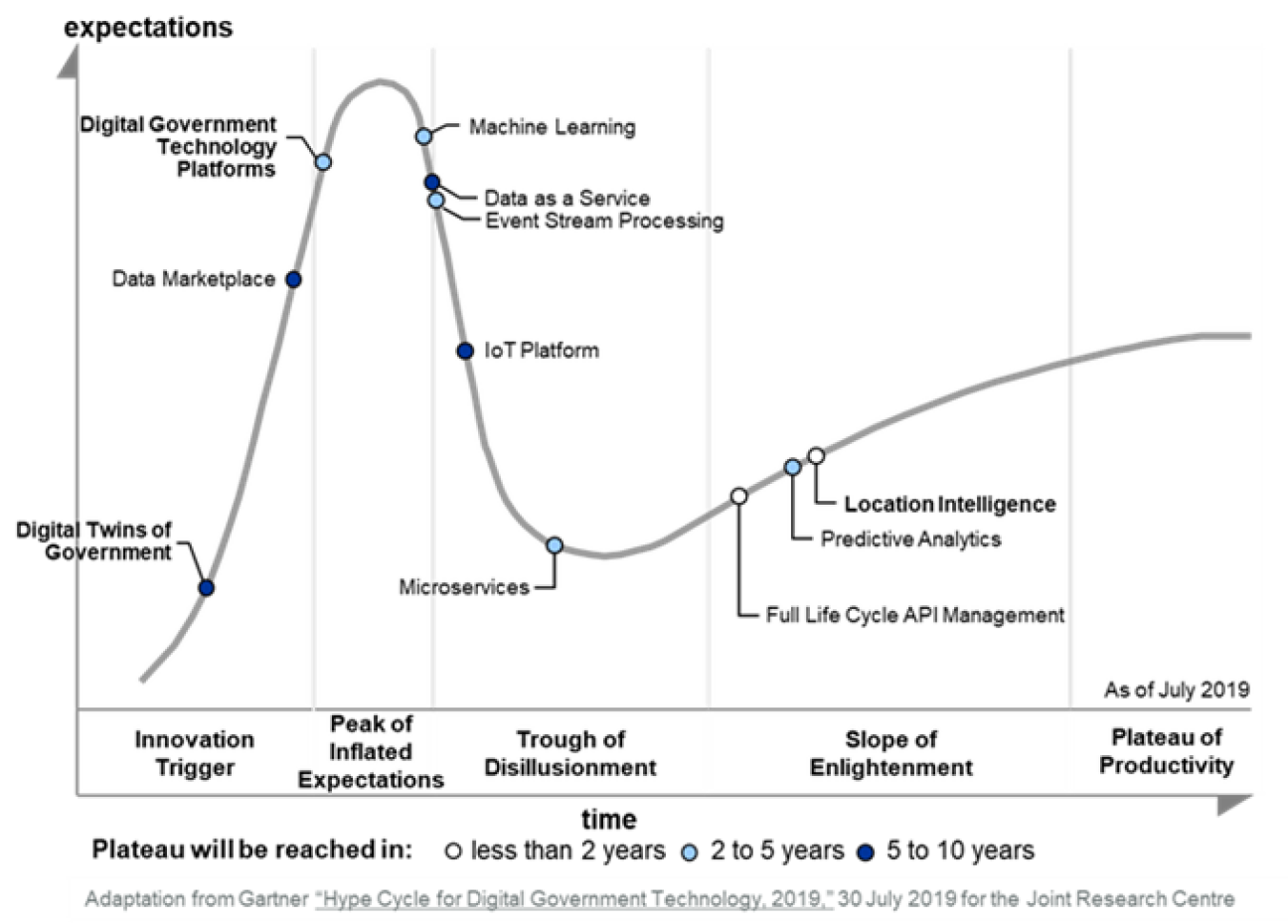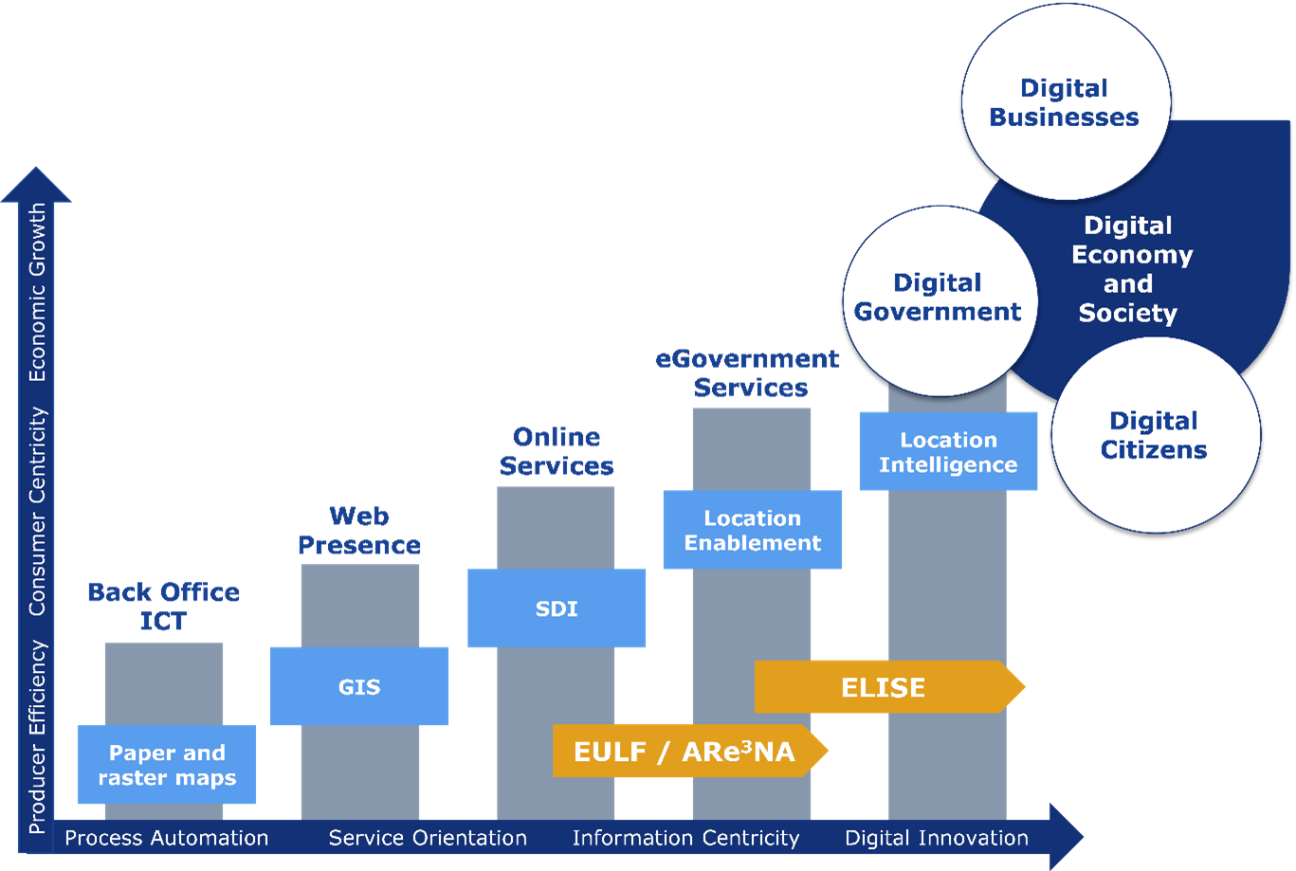An ambitious context for location data in EU digital public services
Location data provides a foundation for delivering added value in combination with other data connected with Government to Government (G2G), Government to Business (G2B) and Government to Citizen (G2C) services, stakeholders or objects from the Internet of Things (devices, machines, buildings etc.).

Location data is used in many fields, including environment, agriculture, regional and local planning, transport, energy, health, and tourism and culture.
To enable this added value, interoperability of location data is fundamental to more effective data ecosystems, services, products and communication with stakeholders, and is a condition for effective use and analysis of location data to deliver efficiency gains.
‘Location Intelligence’, which combines analytics, geospatial information and location-based services, has many use cases in government. Examples are Internet of Things applications that integrate government data (such as demographic data, geological maps or planning/zoning information) into their real-time solutions, including those supporting smart cities. According to Gartner, use of Location Intelligence for Digital Government is evolving, with a timeline to maturity foreseen in less than 2 years (see below). Location Intelligence and underlying data ecosystems are key components in ‘digital platforms’, which enable collaborative provision of digital public services, integration of multiple services, and links with external parties (see Digital Government Technology Platforms, Digital Twins of Government and Data Marketplaces as emerging trends in the diagram). These digital platforms are fuelled by maturing technologies in the areas of data and artificial intelligence.

Public administrations increasingly recognise the value of location information to understand policy impacts, interact with citizens and businesses, and manage resources and emergencies. Consequently, location data, location interoperability and location intelligence play a key role in the digital transformation of government, business and society.
The figure below shows the evolution of digital government and use of location information. There is a common trend towards higher information centricity and digital innovation. The most mature models involve comprehensive digital government strategies, promoting innovation and growth through the use of data, and in particular, the use of location intelligence in applications across all aspects of public life.

This context - growing in ambition - is further challenged by the need for cross-sector and cross-border interoperability supporting these services across Europe, the importance of government-validated core location data in the legal context of digital public services, and the need to integrate other potential location which will emerge from different sources.
An evolving EU digital policy landscape
To support the progress toward Europe’s digital transformation and a fully functioning Digital Single Market, the European Commission – under its priority “A Europe fit for the digital age”- defined a comprehensive Digital Compass outlining the key milestones of its digital strategy for 2030 (Digital Decade 2030). The Digital Compass evolves around four cardinal points (skills, infrastructure, business, and government) to empower businesses and people in a human-centre, sustainable and prosperous digital future.
A key element of the EU’s digital strategy, the European data strategy (02/2020) aims to create a single market for data that will ensure Europe’s global competitiveness and data sovereignty. The European data strategy envisages setting up a series of demand-driven common European data spaces supported by a federated cloud infrastructure in thematic policy areas such as health, mobility and environment, with a “High Impact Project” planned from 2021-27.
The Data Governance Act (DGA) (one of the policy reforms set out by the 2030 Digital Compass and proposed in the European data strategy communication) provides rules and safeguards for the re-use of private data held by the public sector without compromising its protected nature. The DGA is a cross-sectoral instrument that provides a framework to enhance trust and data sharing through the regulation of data intermediaries. Through sector and domain-specific common European data spaces, data will become available in the economy and society while keeping companies and individuals who generate the data in control.
The common European Green Deal data space exploits data in support of Europe’s Green Deal goal to become a climate-neutral continent by 2050. In this context the initiative “GreenData4All” evaluated the INSPIRE Directive together with the Access to Environmental Information Directive to modernise the regime in line with technological and innovation opportunities, reducing administrative burden and facilitating the transition to a carbon-neutral economy. Besides the relevant role that the INSPIRE Directive plays in the environmental data space[1], other data spaces will have spatial elements overlapping with INSPIRE (e.g. transport networks) or involve different or more detailed spatial data themes (e.g. transport, health, energy). Spatial reference data (e.g. address, administrative areas, cadastral parcels) will be important in different data spaces.
Closely related to the above, the Open Data Directive came into force on 17 July 2021. It regulates the re-use of publicly available information held by the public sector and requires Member States to publish existing high-value datasets as open data, using APIs for data access. The Implementing Act on High-Value Datasets defines specific rules supporting the commitments in INSPIRE. Important spatial datasets related to INSPIRE Annex 1 themes are included, e.g. addresses, geographic names, cadastral parcels, and transport networks. These new developments will be taken up in the ongoing revision of the INSPIRE Directive; following its evaluation that took part in the first half of 2022[2].
Complementing the policy framework that is directly addressing data-related matters, the Tallinn Digital Summit of September 2017 and the Conclusions of the European Council on 19 October 2017 indicated the need for the Union to invest in digitising its economies and addressing the skills gap. The European Council concluded that digital transformation offers immense opportunities for innovation, growth, and jobs. It addressed the importance of emerging trends and technologies, data protection, digital rights, fundamental rights, and ethical standards. To support this transition, and as part of the 2030 Digital Compass, the Digital Europe Programme (DEP) is a funding programme for the period 2021 to 2027, focused on bringing digital technology to business, citizens, and public administrations. It provides funding in five key areas: supercomputing, artificial intelligence, cybersecurity, advanced digital skills, and interoperability.
Addressing the latter, the Interoperable Europe initiative was established to foster coordination and adoption of common standards for public services and data flows to reinforce the EU government’s interoperability strategy, as defined in the Communication “Shaping Europe’s digital future”. The initiative is supported by the DEP and builds on the previous efforts of the ISA² programme and the European Interoperability Framework (EIF). The former developed cross-sector and cross-border interoperable digital solutions, and the latter provided specific guidance on how to set up interoperable digital public services. The final evaluation of these two programmes provided input for shaping a future interoperability policy that enhances the interoperability of public services in the EU, by taking into account the needs of stakeholders as well as the role of emerging technologies. This Interoperable Europe policy package is currently under preparation.
In parallel, progress has also been made to define and safeguard European Digital Rights and Principles, again in support of the Digital Decade 2030. With the aim to promote a digital transition shaped by European values, the Declaration on European Digital Rights and Principles published by the European Commission in January 2022 outlines a sustainable, human-centric vision for the digital transformation. This declaration is still under discussion with the European Parliament and Council for eventual adoption.
As the data-driven economy evolves, the need for effective collaboration models will increase. National Spatial Data Infrastructures (NSDIs) will need to become more human-centric and transparent in terms of their governance, priority setting, and support for different actors and use cases. They will have to evolve to support both national and European requirements. Effective data ecosystem support will be needed, bringing together different actors exchanging data around a common purpose. These ecosystems may involve many different elements loosely connected by standards and rules of operation (e.g. road transport, energy efficiency) or more closely connected ecosystems supported by digital collaboration platforms (digital platforms), such as those relating to smart cities. Digital platforms will also be relevant in supporting particular digital public services and in the evolution of data distribution mechanisms, such as data portals and data marketplaces.
Together with the opportunities, there are also uncertainties in how these policy initiatives will evolve and what is meant by some of the new concepts and terminologies. Assumptions used in the Blueprint are shown below.

[1] European Commission, Joint Research Centre, Penninga, F., Lutz, M., Minghini, M., et al., INSPIRE, a public sector contribution to the
[2] Sharing geospatial data on the environment – evaluation (INSPIRE Directive)

